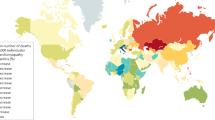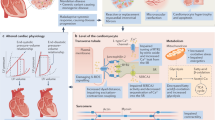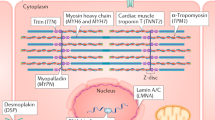Abstract
Cardiomyopathies are disorders affecting heart muscle that usually result in inadequate pumping of the heart. They are the most common cause of heart failure and each year kill more than 10,000 people in the United States. In recent years, there have been breakthroughs in understanding the molecular mechanisms involved in this group of conditions, with knowledge of the genetic basis for cardiomyopathies perhaps seeing the largest advance, enabling clinicians to devise improved diagnostic strategies and preparing the stage for new therapies.
This is a preview of subscription content, access via your institution
Access options
Subscribe to this journal
Receive 51 print issues and online access
$199.00 per year
only $3.90 per issue
Buy this article
- Purchase on Springer Link
- Instant access to full article PDF
Prices may be subject to local taxes which are calculated during checkout





Similar content being viewed by others
References
O'Connell, J. B. & Bristow, M. R. Economic impact of heart failure in the United States: time for a different approach. J. Heart Lung Transplant 13, S107–S112 (1994).
Richardson, P. et al. Report of the 1995 World Health Organization/International Society and Federation of Cardiology Task Force on the definition and classification of cardiomyopathies. Circulation 93, 841–842 (1996).
Kushwaha, S. S., Fallon, J. T. & Fuster, V. Restrictive cardiomyopathy. N. Engl. J. Med. 336, 267–276 (1997).
Corrado, D. et al. Spectrum of clinicopathologic manifestations of arrhythmogenic right ventricular cardiomyopathy/dysplasia: a multicenter study. J. Am. Coll. Cardiol. 30, 1512–1520 (1997).
Thiene, G., Nava, A., Corrado, D., Rossi, L. & Pennelli, N. Right ventricular cardiomyopathy and sudden death in young people. N. Engl. J. Med. 318, 129–133 (1988).
Furlanello, F. et al. Cardiac arrest and sudden death in competitive athletes with arrhythmogenic right ventricular dysplasia. Pacing Clin. Electrophysiol. 21, 331–335 (1998).
Codd, M. B., Sugrue, D. D., Gersh, B. J. & Melton, L. J. Epidemiology of idiopathic dilated and hypertrophic cardiomyopathy. Circulation 80, 564–572 (1989).
Abelman, W. H. & Lorrell, B. H. The challenge of cardiomyopathy. J. Am. Coll. Cardiol. 13, 1219 (1989).
Towbin, J. A. in The Molecular and Clinical Genetics of Cardiac Electrophysiological Disease Ch. 13 (eds Berul, C. I. & Towbin, J. A.) 195–218 (Kluwer Academic, Norwell, MA, 2000).
Report of the 1995 World Health Organization/International Society and Federation of Cardiology Task Force on the Definition and Classification of Cardiomyopathies. Circulation 93, 841–842 (1996).
Gillum, R. F. Idiopathic cardiomyopathy in the United States. Am. Heart J. 111, 752–755 (1986).
Grunig, E. et al. Frequency and phenotypes of familial dilated cardiomyopathy. J. Am. Coll. Cardiol. 31, 186–194 (1998).
Durand, J. B. et al. Localization of a gene responsible for familial dilated cardiomyopathy to chromosome 1q32. Circulation 92, 3387–3389 (1995).
Siu, B. L. et al. Familial dilated cardiomyopathy locus maps to chromosome 2q31. Circulation 99, 1022–1026 (1999).
Li, D. et al. Desmin mutations responsible for idiopathic dilated cardiomyopathy. Circulation 100, 461–464 (1999).
Barresi, R. et al. Disruption of heart sarcoglycan complex and severe cardiomyopathy caused by β-sarcoglycan mutations. J. Med. Genet. 37, 102–107 (2000)
Tsubata, S. et al. Mutations in the human δ-sarcoglycan gene in familial and sporadic dilated cardiomyopathy. J. Clin. Invest. 106, 655–662 (2000).
Krajinovic, M. et al. Linkage of familial dilated cardiomyopathy to chromosome 9. Am. J. Hum. Genet. 57, 846–852 (1995).
Bowles, K. R. et al. Gene mapping of familial autosomal dominant dilated cardiomyopathy to chromosome 10q21–23. J. Clin. Invest. 98, 1355–1360 (1996).
Kamisago, M. et al. Mutations in sarcomeric protein genes as a cause of dilated cardiomyopathy. N. Engl. J. Med. 343, 1688–1696 (2000).
Olson, T. M., Kishimoto, N. Y., Whitby, F. G. & Michels, V. V. Mutations that alter the surface change of α-tropomyosin are associated with dilated cardiomyopathy. J. Mol. Cell. Cardiol. 33, 723–732 (2001).
Olson, T. M., Michels, V. V., Thibodeau, S. N., Tai, Y. S. & Keating, M. T. Actin mutations in dilated cardiomyopathy, a heritable form of heart failure. Science 280, 750–752 (1998).
Mogensen, J. et al. α-Cardiac actin is a novel disease gene in familial hypertrophic cardiomyopathy. J. Clin. Invest. 103, R39–R43 (1999).
Thierfelder, L. et al. α-tropomyosin and cardiac troponin T mutations cause familial hypertrophic cardiomyopathy: a disease of the sarcomere. Cell 77, 701–712 (1994).
Carlsson, L. & Thornell, L.-E. Desmin-related myopathies in mice and man. Acta Physiol. Scand. 171, 341–348 (2001).
Hack, A. A., Groh, M. E. & McNally, E. M. Sarcoglycans in muscular dystrophy. Microsc. Res. Tech. 48, 167–180 (2000).
Sakamoto, A. et al. Both hypertrophic and dilated cardiomyopathies are caused by mutation of the same gene, δ-sarcoglycan, in hamster: an animal model of disrupted dystrophin-associated glycoprotein complex. Proc. Natl Acad. Sci. USA 94, 13873–13878 (1997).
Coral-Vazquez, R. et al. Disruption of the sarcoglycan-sarcospan complex in vascular smooth muscle: a novel mechanism for cardiomyopathy and muscular dystrophy. Cell 98, 465–474 (1999).
Kass S. et al. A gene defect that causes conduction system disease and dilated cardiomyopathy maps to chromosome 1p1–1q1. Nature Genet. 7, 546–551 (1994).
Jung, M. et al. Investigation of a family with autosomal dominant dilated cardiomyopathy defines a novel locus on chromosome 2q14–q22. Am. J. Hum. Genet. 65, 1068–1077 (1999).
Olson, T. M. & Keating, M. T. Mapping a cardiomyopathy locus to chromosome 3p22–p25. J. Clin. Invest. 97, 528–532 (1996).
Messina, D. N., Speer, M. C., Pericak-Vance, M. A. & McNally, E. M. Linkage of familial dilated cardiomyopathy with conduction defect and muscular dystrophy to chromosome 6q23. Am. J. Hum. Genet. 61, 909–917 (1997).
Fatkin, D. et al. Neonatal cardiomyopathy in mice homozygous for the Arg403Gln mutant in the α-cardiac myosin heavy chain gene. J. Clin. Invest. 103, 147–153 (1999).
Brodsky, G. L. et al. Lamin A/C gene mutation associated with dilated cardiomyopathy with variable skeletal muscle involvement. Circulation 101, 473–476 (2000).
Berko, B. A. & Swift, M. X-linked dilated cardiomyopathy. N. Engl. J. Med. 316, 1186–1191 (1987).
Towbin, J. A. et al. X-linked dilated cardiomyopathy (XLCM): molecular genetic evidence of linkage to the Duchenne muscular dystrophy gene at the Xp21 locus. Circulation 87, 1854–1865 (1993).
Muntoni, F. et al. Brief report: deletion of the dystrophin muscle-specific promoter region associated with X-linked dilated cardiomyopathy. N. Engl. J. Med. 329, 921–925 (1993).
Hoffman, E. P., Brown, R. H. & Kunkel, L. M. Dystrophin: the protein product of the Duchenne muscular dystrophy locus. Cell 51, 919–928 (1987).
Meng, H., Leddy, J. J., Frank, J., Holland, P. & Tuana, B. S. The association of cardiac dystrophin with myofibrils/z-discs regions in cardiac muscle suggests a novel role in the contractile apparatus. J. Biol. Chem. 271, 12364–12371 (1996).
Kaprielian, R. R., Stevenson, S., Rothery, S. M., Cullen, M. J. & Severs, N. J. Distinct patterns of dystrophin organization in myocyte sarcolemma and transverse tubules of normal and diseased human myocardium. Circulation 101, 2586–2594 (2000).
Campbell, K. P. Three muscular dystrophies: loss of cytoskeleton–extracellular matrix linkage. Cell 80, 675–679 (1995).
Chang, W. J. et al. Neuronal nitric oxide synthase and dystrophin-deficient muscular dystrophy. Proc. Natl Acad. Sci. USA 93, 9142–9147 (1996).
Cox, G. F. & Kunkel, L. M. Dystrophies and heart disease. Curr. Opin. Cardiol. 12, 329–343 (1997).
Allamand, V. & Campbell, K. P. Animal models for muscular dystrophy: valuable tools for the development of therapies. Hum. Mol. Genet. 9, 2459–2467 (2000).
Heydemann, A., Wheeler, M. T. & McNally, E. M. Cardiomyopathy in animal models of muscular dystrophy. Curr. Opin. Cardiol. 16, 211–217 (2001).
Petrof, B. J., Shrager, J. B., Stedman, H. H., Kelly, A. M. & Sweeny, H. L. Dystrophin protects the sarcolemma from stresses developed during muscle contraction. Proc. Natl Acad. Sci. USA 90, 3710–3714 (1993).
Towbin, J. A. The role of cytoskeletal proteins in cardiomyopathies. Curr. Opin. Cell Biol. 10, 131–139 (1998).
Bowles, N. E., Bowles, K. R. & Towbin, J. A. The “Final Common Pathway” hypothesis and inherited cardiovascular disease: the role of cytoskeletal proteins in dilated cardiomyopathy. Herz 25, 168–175 (2000).
Barth, P. G. et al. An X-linked mitochondrial disease affecting cardiac muscle, skeletal muscle and neutrophil leucocytes. J. Neurol. Sci. 62, 327–355 (1983).
Kelley, R. I. et al. X-linked dilated cardiomyopathy with neutropenia, growth retardation, and 3-methylglutaconic aciduria. J. Pediatr. 119, 738–747 (1991).
Bione, S. et al. A novel X-linked gene, G4.5. is responsible for Barth syndrome. Nature Genet. 12, 385–389 (1996).
D'Adamo, P. et al. The X-linked gene G4.5 is responsible for different infantile dilated cardiomyopathies. Am. J. Hum. Genet. 61, 862–867 (1997).
Bleyl, S. B. et al. Neonatal, lethal noncompaction of the left ventricular myocardium is allelic with Barth syndrome. Am. J. Hum. Genet. 61, 868–872 (1997).
Arber, S. et al. MLP-deficient mice exhibit a disruption of cardiac cytoarchitectural organization, dilated cardiomyopathy, and heart failure. Cell 88, 393–403 (1997).
Badorff, C. et al. Enteroviral protease 2A cleaves dystrophin's evidence of cytoskeletal disruption in an acquired cardiomyopathy. Nature Med. 5, 320–326 (1999).
Maron, B. J. Hypertrophic cardiomyopathy. Lancet 350, 127–133 (1997).
Jarcho, J. A. et al. Mapping a gene for familial hypertrophic cardiomyopathy to chromosome 14q1. N. Engl. J. Med. 321, 1372–1378 (1989).
Towbin, J. A. Molecular genetics of hypertrophic cardiomyopathy. Curr. Cardiol. Rep. 2, 134–140 (2000).
Thierfelder, L. et al. A familial hypertrophic cardiomyopathy locus maps to chromosome 15q2. Proc. Natl Acad. Sci. USA 90, 6270–6274 (1993).
Mann, C. J. et al. Antisense-induced exon skipping and synthesis of dystrophin in the mdx mouse. Proc. Natl Acad. Sci. USA 98, 42–47 (2001).
Ahmad, A., Brinson, M., Hodges, B. L., Chamberlain, J. S. & Amalfitano, A. Mdx mice inducibly expressing dystrophin provide insights into the potential of gene therapy for Duchenne muscular dystrophy. Hum. Mol. Genet. 9, 2507–2515 (2000).
Nowak, K. J. et al. Mutations in the skeletal muscle α-actin gene in patients with actin myopathy and nemaline myopathy. Nature Genet. 23, 208–212 (1999).
Ichida, F. et al. Novel gene mutations in patients with left ventricular noncompaction or Barth syndrome. Circulation 103, 1256–1263 (2001).
Dalloz, F., Osinska, H. & Robbins, J. Manipulating the contractile apparatus: genetically defined animal models of cardiovascular disease. J. Mol. Cell. Cardiol. 33, 9–25 (2001).
Fatkin, D. et al. Neonatal cardiomyopathy in mice homozygous for the Arg403Gln mutation in the α-cardiac myosin heavy chain gene. J. Clin. Invest. 103, 147–153 (1999).
Marian, A. J. et al. A transgenic rabbit model for human hypertrophic cardiomyopathy. J. Clin. Invest. 104, 1683–1692 (1999).
Kittleson, M. D. et al. Familial hypertrophic cardiomyopathy in Main Coon cats. An animal model of human disease. Circulation 99, 3172–3180 (1999).
Shou, W. et al. Cardiac defects and altered ryanodine receptor function in mice lacking FKBP12. Nature 391, 489–492 (1998).
Grady, R. M. et al. Role for α-dystrobrevin in the pathogenesis of dystrophin-dependent muscular dystrophies. Nature Cell Biol. 1, 215–220 (1999).
Clemens, P. R. et al. In vivo muscle gene transfer of full-length dystrophin with an adenoviral vector that lacks all viral genes. Gene Ther. 3, 965–972 (1996).
Braunwald, E. & Bristow, M. R. Congestive heart failure: fifty years of progress. Circulation 102, IV-14–IV-23 (2000).
Deng, M. C. et al. Mechanical circulatory support for advanced heart failure. Effect of patient selection or outcome. Circulation 103, 231–237 (2001).
Stetson, S. J. et al. Evidence for reversible dystrophin abnormalities in patients with non-familial dilated cardiomyopathies: observations in patients treated with long-term mechanical support. Circulation 102, II–132 (2000).
Cohn, R. D. et al. Prevention of cardiomyopathy in mouse models lacking smooth muscle sarcoglycan-sarcospan complex. J. Clin. Invest. 107, R1–R7 (2001).
Towbin, J. A. & Bowles, N. E. Sarcoglycan, the heart, and skeletal muscles: new treatment, old drug? J. Clin. Invest. 107, 154–154 (2001).
Author information
Authors and Affiliations
Corresponding author
Rights and permissions
About this article
Cite this article
Towbin, J., Bowles, N. The failing heart. Nature 415, 227–233 (2002). https://doi.org/10.1038/415227a
Issue Date:
DOI: https://doi.org/10.1038/415227a
This article is cited by
-
State-of-the art review: Noncompaction cardiomyopathy in pediatric patients
Heart Failure Reviews (2022)
-
Dilated cardiomyopathy: a new insight into the rare but common cause of heart failure
Heart Failure Reviews (2022)
-
Elamipretide for Barth syndrome cardiomyopathy: gradual rebuilding of a failed power grid
Heart Failure Reviews (2022)
-
Genetic Basis and Genotype–Phenotype Correlations in Han Chinese Patients with Idiopathic Dilated Cardiomyopathy
Scientific Reports (2020)
-
Natural killer cells impede the engraftment of cardiomyocytes derived from induced pluripotent stem cells in syngeneic mouse model
Scientific Reports (2019)
Comments
By submitting a comment you agree to abide by our Terms and Community Guidelines. If you find something abusive or that does not comply with our terms or guidelines please flag it as inappropriate.



